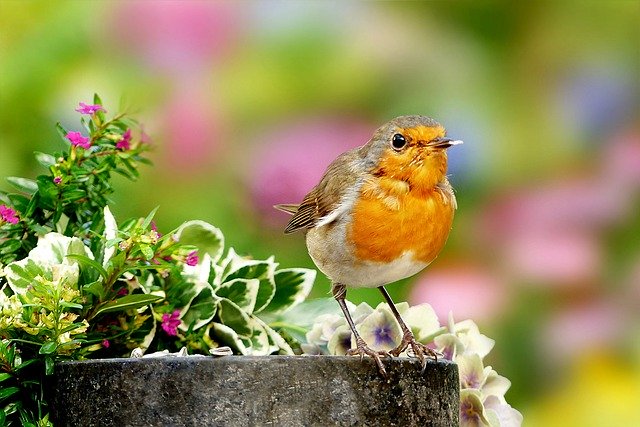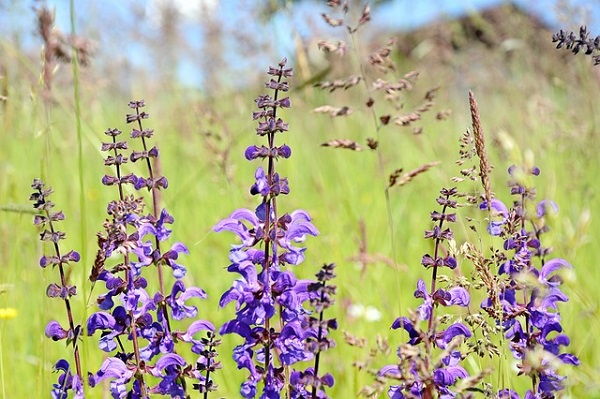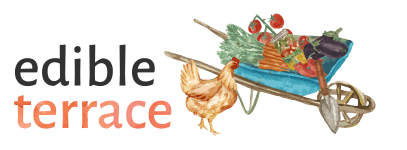Hey! By the way… TheEdibleTerrace is reader-supported. When you buy through links on our site, we may earn an affiliate commission and as an Amazon affiliate, we earn from qualifying purchases. Thanks in advance for your support!

Ah Spring! We love watching the new life that emerges after all those months of cold. The snow is melting away. We can see little green shoots coming out of the trees. And the birds! The birds are singing their song and welcoming in new life! Would you like to see more of them this year? Yes? Me too! Let’s talk about how to get birds in your yard!
How To Attract Wild Birds To Your Yard
There are three main things birds need in a home base: food, water and shelter. And because it is spring, they also need good nesting sites. So, what can you do to encourage them to come to your backyard and create a home for their future family?
Let’s focus on landscaping first.

Wild Sage
Rake up the dead grass (and frozen ground where you can) to not only loosen it but also stir up insects for your avian friends. Do not immediately throw away that loose foliage as the birds will use it for their nests.
When you prune your trees and shrubs, leave that material too in a brush pile, as the birds will shelter in it until your tree leaves have returned.
Plant early blooming flowers in colors that attract birds. Were you aware certain species were attracted to specific colors?
- Red and Pink: Hummingbirds are attracted to these flower colors primarily
- Orange: Orioles, Hummingbirds
- Yellow: Goldfinches, Warblers, Hummingbirds
- Blue: Bluebirds, Jays
- Camouflage colors such as gray, brown and dull green: Doves, Quail, and other ground feeders
Avoid white flowers. White is used to signal danger to the birds. For example, the white on a mockingbird’s wings alarms our bird friends.
Find natural ways to fertilize or kill unwanted insects. Those artificial chemicals are toxic to our friends.
Bird window collisions are a problem. Some ideas to help your new friends see yours: keep blinds partially down or closed so reflections are minimized, hang sheer curtains (which reflect the glare), put up window decals or sun catchers. Or, keep your windows slightly dirty (What an excuse NOT to clean the windows!).
Ensure They Have Food
[easyazon_image align=”right” height=”336″ identifier=”B015AKL92C” locale=”US” src=”https://m.media-amazon.com/images/I/51At33whglL.jpg” tag=”edibleterrace-20″ width=”350″]Check your bird feeders. Chances are they need a good cleaning. Remember that old bird seed begins to grow bacteria which is very harmful to birds. Do you see any damage on the feeders? How do the feeding ports look? Will they hold the bird still?
Rake up seed remnants underneath the feeder too. Another breeding ground for harmful bacteria.
Do your feeders need to be shifted to a new branch? Are the squirrels a problem? Have you considered a bird feeder post? They’re incredibly useful. Or investing in a squirrel proof bird feeder? You could also add a baffle to your feeder.
Some spring appropriate food to offer your avian friends are nectar, mealworms and fruit. Additionally, they need to add calcium to their diet at this time. This mineral is important for eggshell formation and bone strength among many other attributes. Some sources of calcium are: crushed oyster shells, sand, bones from carrion carcasses, shed deer antlers, and mortar and lime from between bricks.
Suet is an excellent choice to offer your Spring arrivals. Birds are in need of the extra energy provided by this meal. Here is a link from Birds and Blooms Magazine for homemade Suet recipes.
Give Them Fresh Clean Water
[easyazon_infoblock align=”right” identifier=”B01HC76V9C” locale=”US” tag=”edibleterrace-20″]Necessary for all life yes? Your avian friends are no exception.
Do you already have a bird bath in your yard? If so, now is the time to clean and sterilize it. Scrub off all waste and algae.
Is it time for the heating element to come out? i.e. your water is no longer freezing?
Were you aware if the bird bath had 2-3 inches of water, your new friends would likely bathe in it? How fun would that be to watch?!?
Birds like to see motion in their water. ** If you add a bubbler or drip, they will be even more attracted to it.
Offer Them Bird Friendly Shelters

Do you already have bird houses and nesting boxes up in your yard? If so, clean them out and sanitize with a weak bleach solution. Repair any damage you find. Keep in mind you are helping raise the next generation so you want them to be as safe as possible.
Are you considering putting up new houses? If you do, hang or mount them at varying heights around your yard so the birds have many choices.
And put the bird houses somewhat near trees or shrubs so the birds have someplace to flee quickly if they are in danger.
Protect Them From Predators
Some of the ways to protect your new bird neighbors in their new homes are:
- Install a metal hole restrictor in the entrance hole. This will keep the predators from chewing their way in.
- Push a tube into the hole. Think PVC pipe. The birds do not mind the long hallway and it protects them from those species who are able to reach in with their ahem…paw.
- Remove the perch. Birds do not need it but the predators use it to hold steady.
- Put the bird house on a metal pole-at least 10ft off the ground. Many predators can climb wood without a problem but cannot climb up metal.
Now that you’re an expert…
Now that you have learned a few ways on how to get birds in your yard, my hope is that with some diligence and preparation, your backyard can become a regular annual stop for the birds that fly through your neighborhood each season. If you have not already begun, consider journaling when you see the various species arrive at your home. This is so you can always be prepared in advance for their arrival. It creates more likelihood for them to stick around.
Would you like to learn what trees, shrubs, flowers attract birds? Find that out here.
Download this printable of the best bird seed to attract birds.
